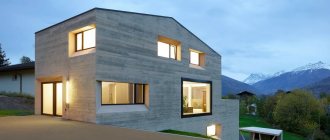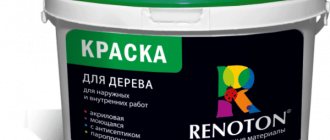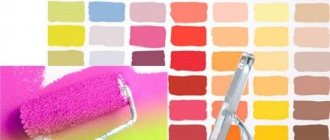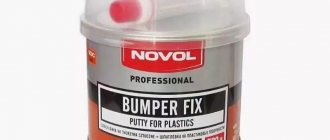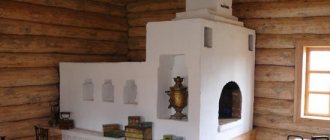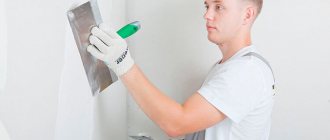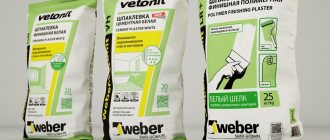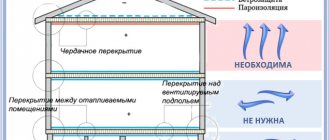Concrete is one of the most ancient building materials; the earliest examples date back to the sixth millennium BC. In those days, clay and lime were used as binders. Modern concrete with cement has been known since 1844, since then it has become the most used building material. It has a lot of advantages, but only one drawback - its unpresentable appearance. To improve design characteristics, various mineral additives are used during the production of concrete or its surface is painted. We won’t touch on additives, but rather talk about wear-resistant concrete paints for exterior use.
Wear-resistant concrete paint for exterior use
How to choose concrete paint for facades?
Paint requirements
The use of correctly selected facade dyes for treating concrete surfaces not only improves the appearance of structures, but also significantly extends their service life. That is why specialists have a number of requirements for coating concrete surfaces:
- increased strength;
- resistance to mechanical stress;
- anti-corrosion qualities;
- wind resistance;
- frost resistance;
- UV resistance.
What should you consider when choosing paint?
The most important property of facade paints for concrete is moisture resistance, since the coating will be regularly exposed to moisture.
In addition, the composition must be resistant to fire, which means it must not contain flammable substances.
No less significant properties of such coatings are:
- good adhesive ability - if façade paint on concrete does not adhere well to the base, then peelings cannot be avoided in the future;
- UV resistance - in this case the coating will not fade under direct sunlight;
- ability to withstand temperature fluctuations – the coating must easily tolerate temperature changes from -40 to +40 degrees;
- ability to pass steam - otherwise condensation will accumulate on the surface;
- resistance to stains - the paint must contain antibacterial components that will prevent the formation of mold and mildew.
Consumption per 1m2
Consumption standards for façade paints for concrete depend on the type of dye:
- acrylic compositions: 130-200 g/m2;
- alkyd compositions: 100 g/m2;
- oil compositions: 150 g/m2;
- silicate compositions: 100-400 g/m2;
- rubber compounds: 100-300 g/m2;
- water-based compositions: 110-130 g/m2.
Features of rubber paint
Relatively recently, a new product appeared on sale - rubber-based paint. It contains many components (additives of silicone, acrylic and other components), thanks to which the composition is easy to apply and forms a moisture-resistant coating on the surface that does not fade or become damaged for a long time.
In addition, rubber paints have the following advantages:
- noise absorption;
- environmental friendliness;
- the ability to choose from a wide range of colors;
- resistance to chemicals, fungi and mold;
- high elasticity;
- good vapor permeability;
- waterproofing properties.
In addition, rubber concrete paint can be easily removed if at some point you decide to update the finish. To do this, it is enough to use “gentle” washes.
Healthy! After the paint dries, it becomes matte.
Most often, rubber paint is used for concrete floors in apartments, garages, gyms, balconies and so on. Since the composition does not lose its properties at temperatures from -55 to +60 degrees, it is often used to treat street paths, blind areas and fences. If you are deciding what to paint your foundation with, modern rubber paint is a good choice.
Healthy! The paint cannot be applied in a thick layer, so it is used to cover surfaces in 2-3 stages.
It's also worth considering a few tips on how to paint a concrete floor if you're doing the work yourself.
Technology for painting a concrete facade: instructions and video
Is it possible to paint aerated concrete without plaster?
The classic algorithm for preparing a concrete surface for subsequent painting is not always appropriate, especially if painting the walls is only a temporary measure to create the final appearance of the house.
If plastering of the walls is not planned, it is necessary to understand that the porosity of the facade contributes to a high absorption of moisture, which means the dye consumption can increase by five times.
In this case, a mandatory preparation step will be priming the surface with several layers of deep penetration soil solution. Two or three layers of primer will reduce the absorbency of the material, which will significantly reduce dye costs.
After priming, any suitable material for facade work can be applied to the surface. The main thing is to pay attention to the dye consumption and take at least twice as much material.
How to prepare the surface
Before applying the composition, it is necessary to carefully prepare the surface:
- clean the walls from dirt and dust;
- eliminate existing defects using plaster;
- prime the walls (to improve the adhesion of the coating to the concrete).
The end result should be as flat and smooth a surface as possible.
The process of preparing concrete walls for painting is described in detail in the following video:
How to apply paint correctly
You can apply the paint in any convenient way - with a brush, roller or spray.
Experts strongly recommend using a roller to apply the first layer, and using a spray bottle exclusively for the second and subsequent layers - in this case, it will be possible to achieve the most even coating. It is recommended to use a brush to apply dye to hard-to-reach places.
How to paint concrete surfaces
In order to perform staining correctly, perform the following simple manipulations:
- Before painting concrete yourself, remove debris, dirt and dust from the surface to be painted.
Healthy! If you are applying the composition to the floor in a multi-story building, then make sure that the concrete screed located on the ceiling is not damaged. If there are chips in it, repair them.
- Apply primer to the base (if necessary).
- Mark the boundaries of the area to be painted with masking tape.
- Mix the mixture thoroughly and pour a small amount of paint into the tray.
- Lower the brush 1/3 of the way into the tray.
- Apply the durable concrete floor paint evenly (brush on the edges and roller on the center).
Healthy! You can also use an airless spray gun (pressure 200 bar).
- Wait until the first coat of paint has dried (good air circulation must be ensured in the room) and apply the next coat, if the instructions for the composition indicate that a two-layer coating is required.
Also keep in mind that before painting a concrete floor or wall, you need to prepare a solvent for cleaning brushes and take care of personal protective equipment (gloves, a respirator and clothing that you don’t mind).
It is better to paint at a temperature 2-3 degrees above the dew point.
Where to buy concrete paint for exterior use?
In Moscow
In Moscow, you can purchase façade paints for concrete from the following organizations:
- “Master Tibot”: official website: https://mastertibot.ru;
- address: Moscow, Kyiv highway, 2nd kilometer;
- telephone.
- official website: https://www.mirkrasok.ru;
- official website: https://1001kraska.ru;
In St. Petersburg
In St. Petersburg, the following companies sell facade paints for concrete surfaces:
- “Vlagoshchit”: official website: https://vlagoshchit.rf;
- address: St. Petersburg, Yakhtennaya street, building 3, building 2;
- telephone.
- "Olvia": official website: https://olvia-color.ru;
- address: St. Petersburg, Glukhoozerskoe highway, building 11;
- telephone.
- official website: https://petrovich.ru
Thus, the modern construction market allows you to choose facade paint for concrete to suit every taste and color. Therefore, if you can’t choose a color yourself, you should trust a specialist. The work experience and professional skills of a sales consultant or an experienced craftsman will allow you to select a dye in strict accordance with the requirements and wishes of the customer, as well as taking into account all the features of a particular facade.
Did this article help you? We would be grateful for your rating:
Painting inside and outside, what's the difference?
There is a difference when painting concrete walls inside and outside. These are completely different conditions. On the street, the wall is exposed to negative influences. As for coloring, there are two differences:
- Temperature conditions. Concrete indoors is in “greenhouse” conditions and is not exposed to sudden changes and frost. The same cannot be said about external surfaces. Therefore, work there must be carried out at temperatures above 5 ℃. Also, the process is performed in cloudy weather, when direct sunlight does not hit the concrete.
- Lead time. Painting concrete inside can be done at any time. And external work must be carried out depending on the weather and time of day, so that morning and evening dew does not form.
If these conditions are met, the paint applied to the concrete outside will not crack and will last much longer.
Types and technical characteristics
There are different types of paints - for external and internal work, for various materials. The technical characteristics of the compositions vary slightly, so it is necessary to consider some points before starting work. Manufacturers may recommend first diluting the composition with water or a solvent (depending on the original components).
Attention! After applying the solvent, the surface may become matte or glossy.
When choosing, you need to take into account that not all acrylic paints have the same composition. Components (main and additional) are indicated by the manufacturer on the packaging. A high-quality product dries quickly after application to the surface, after which cracking or streaks do not appear on it. The selected color scheme is uniform without sharp transitions or smudges. Technical characteristics do not allow delamination, even if the paint is applied to the surface several times.
pH values below 6.5 or above 9.5. Experts indicate that acrylic compounds protect wooden structures better and better. If concrete is chosen as the main material for creating the facade and external structures, then acrylic paint will protect them from mold formation and provide a high degree of protection from mechanical and natural influences.
Technical specifications indicate that before applying paint, the concrete surface should be prepared - the old coating should be completely removed. In 90% of cases, 1 layer is enough for high-quality coloring.
Indoors, acrylic paint can be used as the main coating. It is also used as a basis for decorative elements, such as painting in a nursery or on certain objects.
Interesting! Treatment is also required near heating sources (radiators, air conditioners).
Matte paint is used for different types of surfaces, for example, for the base. The glossy composition is suitable for surfaces that are perfectly smooth or well prepared for the painting process in advance. This option should be used when you want to create a shiny facade. You can also purchase pearlescent dye. It contains an inorganic filler. It should be used in finishing work when you want to visually enlarge the room. This type is not used for exterior decoration or is an addition to the main visual effect.
For facade work
Carrying out facade work requires purchasing such types of paints as:
- organics;
- water-based.
Organic paint works well in winter and can withstand frost down to -30 degrees. The coating applied to the facade will be smooth and dry quickly. Additionally, the composition contains color pigments and resins.
The water base assumes that the additional components will be a variety of polymer particles and dyes. The coating performs a protective function and gives a rich shade to the treated surface. The main advantage is the complete prevention of corrosion. Application on materials such as concrete, brick, plaster, aerated concrete and facades with a porous structure shows good results.
For wooden facades
Advantages:
- high expression of protection;
- strengthening the structure of natural material;
- immunity to temperature fluctuations;
- protection from moisture and fungus.
A facade treated with such a composition will look perfect for a long time and will not require repair or restoration work. The selected color and shine are well preserved on the wood. It is easy to obtain the desired color, since the selected options form a homogeneous mass and are easy to apply without leaving stains. Wooden coverings need unhindered air flow. Acrylic allows you to create natural additional ventilation on the facade.
The vapor conductivity of the composition is also very good (the facades of baths or saunas can be treated). If the surface has minor damage or defects, then a coating of 2-3 layers can hide most of them due to the elasticity of the composition. There is no sharp unpleasant odor, and there are no toxic compounds. For application use a roller or wide brush. For large surfaces, it is recommended to use a spray gun. Preliminary preparation of the facade (cleaning) may not be necessary.
For external concrete work
Capital buildings and residential buildings are often built from concrete. Its exterior painting is carried out using acrylic paints with great efficiency. The treated surfaces will be reliably protected from any negative manifestations, since the paint forms a durable and wear-resistant layer. Color indicators are maintained for several years. Protection also works against chemicals, mold, mildew, high humidity and condensation. In order to obtain high-quality treatment and make the coating fully functional, it is necessary to carry out preliminary preparation of the facade: rid it of any contaminants, including dust, and, if necessary, remove the old layer of paint. In most cases, one coat of paint is sufficient.
VD-AK-101
Water-dispersion acrylic paint - suspension. Used for high-quality painting of facade surfaces. This type of composition has pronounced adhesion and demonstrates resistance to temperature changes and atmospheric conditions. After drying, it provides additional protection against moisture (a thin layer appears that prevents its accumulation). If there is a need to wash the facade, then the coating allows you to do this. Can be applied using a roller. The layers are smooth, matte or silky.
GOST 28196-89 requirements for acrylic paints
Existing standards indicate that the paint must meet the parameters: after application there are no smudges or delamination after drying. Requirements for the content of volatile substances – no more than 57%. Acidity levels range from 6.5-9.5. Cold resistance. Total drying time: 18 hours.
Water-dispersible acrylic
Operational and mechanical parameters are regulated by established standards. Indicators that must be taken into account:
- homogeneous film;
- in the container it is smooth upon visual inspection;
- color is even;
- non-volatile substances in the composition do not exceed 57%, but cannot be less than 47%;
- acidity indicators are not higher than 9.5.
The paint is frost-resistant. Drying 100% may take up to 1.5 days. The composition demonstrates resistance to light and mechanical stress. The created coating is durable, the brightness of the color does not change. During painting work there is no characteristic sharp chemical smell. Attached is a certificate of conformity.
Polyurethane enamel
The dye has all the necessary characteristics - it is resistant to most types of negative influences, is not afraid of chemicals, precipitation, and temperature changes.
But the main advantage is the spectacular look that paint can give to concrete surfaces. Among the interesting options is luminous enamel, which makes even the most inconspicuous concrete wall unique.
Preparing the base for painting
The concrete surface is characterized by an insufficiently strong top layer, which can affect the quality of painting. In order to ensure maximum adhesion to the wall, a number of measures should be taken to prepare the walls:
- level the surface . To do this, it is necessary to eliminate sharp protrusions, seal seams and cracks;
- clean the base . If there are oil stains, they should be removed with concrete (the thickness of the recess is up to three centimeters), and the recess should be sealed with fresh mortar. Clean the entire surface from dust and debris.
IMPORTANT!
It is recommended to rinse the surface with water from a hose under pressure : this washes out the top thin, fragile layer, which disrupts the adhesion of the paint to the surface.
In addition, strong pressure can wash out the recesses in the wall, which is a positive point: if these places were painted, they would soon fall off anyway, and it would be necessary to seal this place along with the painted layer.
The resulting depressions should be filled with fresh solution and wait until completely dry.
Briefly about the main thing
For coloring concrete, compositions are used that have the ability to penetrate deeply into a dense base.
Craftsmen prefer acrylic, rubber, polyurethane or epoxy paints.
The choice of materials depends on operating conditions: temperature, humidity, contact with water, mechanical stress.
An alternative to paints are powdered dyes (mineral and acidic dyes are in demand).
Ratings 0
Advantages and features of concrete
The advantages of concrete are:
- the surface on which the concrete product is applied acquires increased strength;
- such material is able to cope with negative environmental phenomena (in the case of the exterior decoration of a building);
- laying concrete is simple and elementary;
- product strength at the highest level;
- the quality is high and the price is low.
In most cases, floors are made of concrete on streets and in industrial premises, basements or garages, and so on. This coating is in demand due to the fact that it can withstand high-level loads.
If we talk about the disadvantages of concrete coating, we can note the release of dust during its use. This problem can only be solved by applying an additional coating to the concrete surface. Most often it becomes laminate or linoleum. But experts say that the most suitable solution in this case may be decorative painting of the surface. This method is affordable and fast. And such application to concrete will provide additional resistance to wear of the material. In addition, painting concrete will give it aesthetics and attractiveness.
